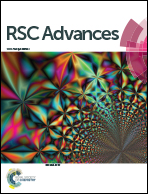Luminescence properties and energy transfer in Tb3+ and Eu3+ co-doped Ba2P2O7 phosphors
Abstract
The Ba2P2O7:Tb3+, Eu3+ phosphors were synthesized by a high temperature solid-state reaction method in air atmosphere and their crystal structures, lifetime, luminescence properties, and energy transfer mechanism were investigated in detail. A series of characteristic emissions of Ba2P2O7:Tb3+, Eu3+ phosphors were observed in the emission spectra at around 545 nm, 593 nm, and 613 nm when excited at 378 nm. The energy-transfer mechanism from Tb3+ to Eu3+ in Ba2P2O7 is determined by a dipole–dipole interaction. The emission intensity of Ba2−xP2O7:xEu3+ was enhanced by doping charge compensation Li+, Na+ and K+. The CIE coordinates of the phosphors can be tuned from blue-green through white, to yellow and finally to orange-red with changing the Eu3+/Tb3+ ratio. The average decay time of Eu3+ increases from 2.10 to 5.81 ms with the concentration of Tb3+ increasing from 2% to 8%, and reaches the maximum at 0.08, and is shortened when the concentration of Tb3+ goes beyond 8%.



 Please wait while we load your content...
Please wait while we load your content...